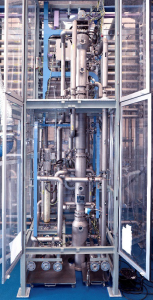30
Aug 2022
Removal of aromatics from oil fractions
In the processing of petroleum crude oils, vacuum distillates and de-asphalted oils (DAO) are among the partial streams. These can be further processed into high quality base oils.
The first step is the removal of aromatics by extraction, which produces Distillate Aromatic Extracts (DAE) and Residual Aromatic Extracts (RAE) as extracts. DAE and RAE are important process oils used in the production of rubber products (tyres, inner tubes, floor coverings).
The polycyclic aromatic hydrocarbons (PCA) contained in DAE and RAE are now classified as highly harmful to health.
EU Directive 2005/69/EC limits the permissible limit value for polycyclic aromatic hydrocarbons (PCA). Limit values are benzo(a)pyrene < 1 mg/kg and total PCA < 10 mg/kg.
In order to fall below these limits, DAE and RAE are further treated by means of a extraction step. The extracts obtained in this way are called Treated Distillate Aromatic Extracts (TDAE) and Treated Residual Aromatic Extract (TRAE).
The market for TDAE and TRAE is growing strongly while DAE and RAE are in decline.
Figure 1: Market development TDAE
A possible technical solution for the extractive removal of aromatics is the Asymmetric Rotating Disk Contactor (ARDC) from Technoforce Solutions. Here, the series counter current circuit of several mixers/settlers (see Fig. 2) of a conventional extraction is transferred to an extraction column.
Figure 2: Conventional arrangement of three mixers/settlers

Figure 3: Structure of the ARDC

The ARDC consists of an axis with rotating discs that ensure mixing of feed and solvent and flow- calmed settling zones in which raffinate and extract can separate. The separate settling zone of the ARDC has significant advantages even against symmetrically designed conventional rotary extractors. The separation is significantly more controlled and thus more effective, as unwanted flow entrainment is avoided.
Approximately 6 mixer/settler stages are realised in one ARDC. The name comes from the off-centre axis of rotation of the mixing zone.
For the removal of aromatics from the DAE, furfural or NMP are used as solvents. While the NMP tolerates higher process temperatures, the possible process temperature for furfural is limited due to the higher partial pressure. However, furfural has a higher selectivity towards mono-aromatics than NMP and can therefore be used in a lower solvent to feed ratio. The process-relevant data are determined in advance by piloting in pilot plants of Technoforce Solutions. Figure 4 shows the settling zones in a glass column, which is used to adjust the flow conditions. Figure 5 shows one of the piloting plants.
Figure 4: Settling zones in an experimental column

Figure 5: ARDC Pilot Plant in Geleen, The Netherlands

Even at lower temperatures, the removal of aromatics to values far below those required by EU Directive 2005/69/EC can be achieved by getting a good TDA yield.
Technoforce has already designed and built more than 60 Asymmetric Rotating Disk Column Units for Petrochemical industry, Fine chemistry, Pharma and other industrial sectors. Within the scope are also other extraction technologies as well as other technologies like Short Path Distillation, Agitated Thin Film Evaporation and Drying, Falling Film, Rising Film and Forced Circulation Evaporation, as well as Liquid-Liquid Extraction and Crystallization.

